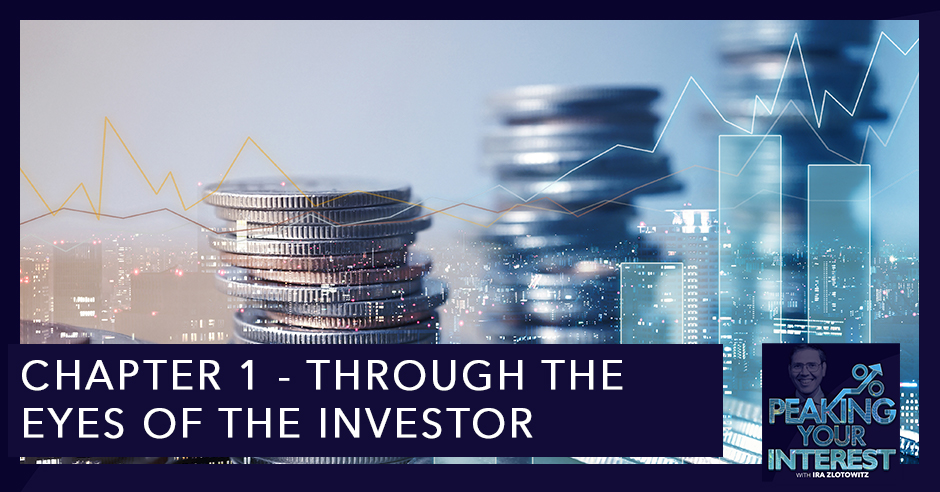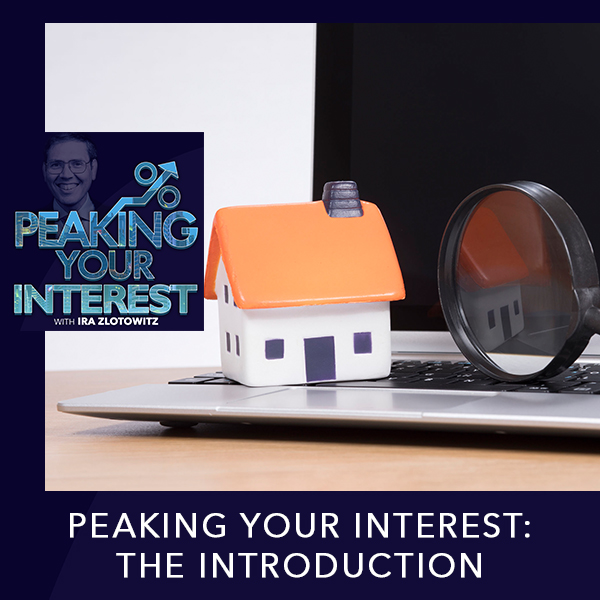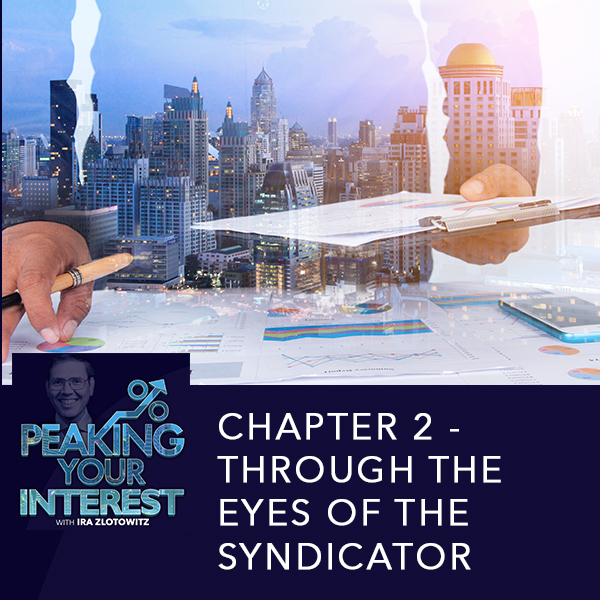Chapter 1 – Through The Eyes Of The Investor
- On February 24, 2020

There are many unique perspectives on investing out there because of the wealth of backgrounds that people who go into investment come from. But when you’re on the other side helping someone else invest, you always have to make sure you’re looking at an investment from the eyes of the investor—considering everything to help them make a decision that’s good for them. Ira Zlotowitz approaches investing not from the perspective of an expert, but of a regular investor. What do people think about when they measure up their investments? Make sure you keep informed about what it is that others are considering before going into their own investments.
—
Listen to the podcast here:
Chapter 1 – Through The Eyes Of The Investor
As we said in the first episode, it was more of the intro. We discussed how we are going to go and view the world through different angles. I want to go into detail. We’re going to focus on through the eyes of the investor. It’s perspective, number one. As we go through the course, we’ll show different perspectives. Who is the investor? What are the investors? Why do they invest money? The investors are a regular, typical person like you and me. We have a job. We make money. We have to say, “What do I want to do with that money? What’s the plan and why do we do something with the money?”
Why Do People Invest Their Money?
The question is, “Why do people invest their money?” There are three main reasons why a person invests their money. The first reason is to protect against inflation. The way to understand this in a simple layman’s terms is that if someone makes $50,000 a year and the $50,000 a year that they make, that’s what it costs for them to support the whole family. All their expenses are $50,000. If every expense is going to go up over the year, the next year to support the family in the same fashion as the year before, let’s say they need $55,000. It’s a big jump. It’s not that high, but that’s a 10% inflation. You went from $50,000 to $55,000. If this person does not earn $55,000 in year number two, they’re going to have to dip into savings or lower the standard of living to move forward.
The other concept, let’s talk about money that way. People talk about how much they want in retirement and they make a calculation. I want to retire based on the lifestyle of now. I would need $50,000 a year. I want to make sure that if I want to live, I want to retire and I want to have money to live for ten years. In theory, don’t take this as actuality. I would need $50,000 a year times ten, I’ll need $500,000. The problem is inflation is going to kick in. If I had $500,000, I could live for ten years, but if inflation kicks in, I can’t live. The first thing a person would want to do was they want to be able to take their money invested somewhere that’s safe, that the return should be at least equivalent to inflation.
Let’s go normal. Inflation fluctuates from 1% to 4%. In such a case like that, I would want to be able to find an investment that’s going to throw off 4% in high-end or 2%. If I was able to throw a 2% every single year on my investment, I will have enough that when I’m ready to retire, I have the cost of living $50,000 plus including the inflation. If I didn’t invest the money, I didn’t put away the money. I’d wake up, have $500,000 but I’m only carrying me for 8 years in my plan, 10 or 7 or 6 years to go from there. The first reason is a person doesn’t want to go backwards. If I have money and at $50,000, I want $50,000 of buying power, inflation’s 2% a year, I have to find a place to invest my money and earn 2% a year. That’s number one. That’s the minimum.
Ideally, you want to retire with enough money saved up to live for ten years. Click To TweetThat’s why people say, “Should I put my money under my mattress?” That concept, “under the mattress” is negative because the $50,000 will not change. It will be $50,000 again next year and $50,000 the year after. If inflation kicks in, I’ll have the buying power of $48,000, the buying power of $46,000, so on and so forth, all the way down. Let’s go to the second point, which is more in reality about why people talk about if they should make an investment. It’s that, “I worked hard. I could take a 9:00 to 5:00 job. I could have two jobs. I could work day and night. I could be a workaholic.” Whatever type of worker you are, you were working hard for your money. You want your money to work as hard as you are.
If at the end of the year, using the same example, you need $50,000 to live and you earn $70,000. You have an extra $20,000 after taxes, let’s say. You want to do something with the money that the money should also make you money, not just you’re working. If you could find that good investment, a risk-based investment, which we’ll talk about, that has a risk versus reward. You’re going to want to go into a situation where you could take that $20,000. Let’s say you make a 10% return on your money and you have $2,000 extra. It comes to the end of this year, I now make $70,000 from my core job, $2,000 that my money made for me. I now earned $22,000 this year. I need the same $50,000 to live with inflation, maybe $51,000 or whatever it was and I have the excess money to go next year.
Instead of investing another $20,000, I have $22,000 to invest or $21,000 to $20,000 from year one. The new $20,000 from this year plus the return of year one’s money, put it together, adjust it for inflation, and I could keep growing my portfolio that way. That is the second point, return on investment. The joke many times as I speak to clients and when I first came into the business. A big client tells me, “Ira, it’s ROI, Return on Investment.” First, make sure you’re getting your money back and then worry about how much profit you have. Many times I meet people, they go into a business deal and they say, “I went into this deal. How much I could make it and if it doesn’t work, it’s going to work. How much can I make? We’re getting into a fight. If I make 40% on my money then realize, I went to a bigger piece to smaller piece.” I said, “What about the actual investment?” “It’s for sure going to be good.”
You look from the wealthiest people, they go the opposite way, return of investment. If I’m investing money first, show me how secure it is and they’ll trade up any day of the week upside if the principal is not secure. Let’s go to the third point. The third point is to return on equity and returns on equity is an important point. Return on equity is what the dream you want to accomplish. If I take my money as an investment number two, in return for my investments. I take my $20,000 and $100,000. It’s around $200,000 and I invest it. I can put it into the bank, I earn, 2% 3% 1%. I can invest it in stock and hope they go 8%, 10%, 12% but the stock market’s going to throw off. There’s risk there.

Perspectives On Investing: After you make sure that you’re going to get your money back, then you can worry about how much your profit will be.
Typically speaking, if I make an investment, I have a return that I make. The next step is on the stock. The value also goes up. Take stock, for example. I bought a share of a stock that’s trading at $20 a share. The stock has a dividend. It pays a dividend. I’m getting a return on my money. Plus, it’s also possible when I sell the stock at the end, not only do I get my $20 back, but the stock can be worth $24. I got my actual equity, my stock is equity. I own something that also went up in values. I’ve got a return and I’ve got equity. Going back for ROI purposes, I put money in the bank. I put $100,000 in the bank. Whatever interest rate it pays me, when I take out my money, I get the same $100,000 back plus I get that return. I’m never getting a call with the bank and the bank’s going to tell me, “Aside from $100,000 you put here and the interest, the $100,000 is worth more.” No, it’s fixed. It’s $100,000.
Three Most Common Investments
The smartest of investors try to find with tax advantages, how can they go out there and solve all the problems? How could they have something that is at least above inflation covered? Number two, have a return that could grow their money to work hard for them. Number three, the actual or what they buy also can go up in value. Those are the three points of the equation. What are the three most common investments? I have money, I want to invest. What are the three ways the most common ways people could go? Number one is the stock market. Number two is you could start to buy a business. Number three, real estate buying or lending.
In the real estate course, I’m going to focus a lot more on that end of it, but I want to give a perspective. When you’re coming in, you understand from the eyes of someone that has money, what are their choices? Let’s walk through those three options. The stock market. There are risks and rewards. What is the reward? The reward is that at any given moment, the stocks are liquid. For the most part, the stock market’s open. You could sell a stock, buy a stock and there’s a market. If you want to get your money back, that investment easily, it could sell out. You’re not subject to finding a buyer going to contract. You can buy and sell right away.
Number two, the sky’s the limit. You can lose your money if you buy a stock, but a business could go through the roof. You could get involved in business early on thinking about Google, Amazon or Facebook. When those companies open up, someone could have bought in regular stock and look where they went to. The sky is the limit. The equity that you have in the stock aside from dividends goes through the roof. What are the negatives? There are two main negatives. Negative number one is a volatile market. The markets could change and people could be more interested in a certain part of technology. People get nervous about the stock market. The volatility in the marketplace and public opinion could determine where your stocks are going.
If you want your money back, your investment could easily sell out. Click To TweetImagine if you were buying retail stocks and then as soon as Amazon came out, people said, “The old retail stores are going to close down and it’s crazy.” Also, the value of retail stocks went down that some people thought, “No, retail is still going to be strong. It’ll be different but still be strong. It doesn’t make a difference.” The public opinion left that retail is strong and they went to a different part of the marketplace. It’s volatile. In the last part, which is tied to the first part, you have no control. Not that you have no control in the market. That’s one thing. You have no control in the business. If you want to go buy, you could have Apple stock. Apple comes out of the new product or they change the pricing or they do something and thinking to yourself, “That’s crazy. Why are they doing that? That’s going to kill themselves. It’s going to kill the market. What’s the thought process? What’s going on?” There’s nothing you could do. I don’t care how much money you have in the stock and invested in a company. The odds are you’re not going to have enough there to have a say.
You have no control. That’s us trusting the public markets. That’s the benefit, the sky is the limit. The benefit is you could buy and sell. If you don’t like what’s going on, sell out. On the flip side of the coin, you have no control and there’s a ton of volatility within a marketplace. Start buying a business. What are the risks? When you want to start a business, the biggest risk is that all invested capital’s at risk. I went up to a pizza shop. I go down rent new space, fix it up. It costs $100,000 to start it up. If the pizza shop doesn’t work and I can’t get customers or there’s a problem, my whole $100,000 is out the window. My full money is at risk. Going back to a stock, I bought stock. Can there be volatility in the market? Yeah. Can the market crash? Yeah. What’s the odds that it’s going to go to zero? When you start a business, it could go to zero. You could put $100,000 in, $200,000 in, $50,000 in and the whole dollar that you put in could go down to zero.
An existing business, on the other hand is maybe less risky because I could go over to a pizza shop that existed that already has revenue and already has profitability. I could buy based on their current profitability in the hopes that I could grow it. It’s still risky. I can make a mistake when I take over. People don’t like that there’s a new owner there. There are risks involved, but it’s more of a hedge risk. The flip side though is you probably have to come up with a lot more money. An existing pizza shop has the same inherent costs. Plus, you’re buying the existing customer base. It has its perks, but you need more money to go into it but you have more security on that end of it. What are the risks? What are the biggest negatives to buying your own business and owning your own business?
The biggest negative is what is your exit? I have a stock market. I want to sell it. On the snap of my fingers, it’s sold. What happens if I go out and buy a business? I have the greatest business in the world, the greatest pizza shop. I have to find someone that’s ready, willing and able to purchase it and interested in purchasing it. I might not be able to get at the right speed. I want to close fast. I might show desperation if I closed fast. That’s viewing it from the eyes when I have money to buy a business. When someone says, “Invest, buy a stock or buy my own business.” The third, which leads to real estate and we’re going to focus on real estate lending and real estate buying is both the same. The pros and cons are approximately the same except for the tax advantages, but let’s break it down.

Perspectives On Investing: The market is volatile. They could change, and people could find themselves more interested in other branches of technology.
Pros And Cons Of Real Estate Investing
Number one, you have the ability to do unlimited due diligence. When you’re going out there and you’re buying yourself a stock, a building, you have the ability to find so much data in the marketplace. There are many data providers. Many people in real estate could tell you every line item if what the seller is telling you with the expenses, if it’s accurate, if you could count on it if you can project it. You want to know what the rent in this area, this technology and I’m doing this in February of 2020. I’m sure people reading these several years from now, there will be new technology, new data and new intel that’s going to be available to people about rental comps. You’ll have much information and that’s getting stronger. It’s less likely you’re going to make a mistake.
Go back to that pizza shop. Maybe the guy gave you his numbers, but the numbers he gave you included items that were unique to him that he had to spend it on or because of his style, he didn’t have to pay for certain things. If you took over, you had those idled expenses. You can’t know that because how many pizza shops are for sale and what public information do we have on it? With real estate, there is unlimited due diligence you can get done. The second thing is that property values typically appreciate it. The real estate value goes up and the reason why the value goes up is there is a concept called landlocked. One thing they’re not developing anymore, they’re not developing any more land. This is it. Look around your neighborhood. It might have a new street name, but they might cut down a forest and turn roads and develop it. The amount of square footage that exists in your city, that’s the same thing that is always going to exist in your city.
You go back to when the World Trade Center was built in Battery Park, they built more land. They bought trucks after trucks and dump land into the water and they extended the city. Again, for the most part, what we’re talking about this landlocked. It’s a matter of as an area gets more populated and denser, the remaining land has to go up in value. Over time, real estate and inflation go up in value. The tax benefits and this tax benefit is for the buying, not for the lending. I’m going to go into these things in a lot more detail, that different part of this course, but just to gloss over it. This 1031 Exchange. The first benefit that you’re able to do is that the government allows you when you’re selling the property and I make a profit. I want to go ahead and invest the money again.
In everything I do in the world, I buy stocks and I buy a business. I buy it for $200,000 keeping everything simple. I buy it for $200,000 and I’ll sell for $300,000. I made $100,000 profit. The government says, “Pay taxes,” whatever the tax bracket is, 20%, 50%. It doesn’t make a difference. The net money of the $50,000 in profit or the $70,000 profit, you can invest that. My next deal, I haven’t taken my initial $200,000 plus, let’s say there’s $70,000 after taxes. I have $270,000 to invest in my next deal. On real estate, the government says, “Pretty much there’s some way to do a 1031 Exchange.”
With real estate, there's an unlimited amount of due diligence that must be done. Click To TweetThis pitch of kids that go into it, but the government says, “You could defer your tax bill as long as you take that $300,000 by a similar type of property. You are able now to go ahead and buy the second property and don’t pay taxes. You’ll pay for it when you sell the next property.” The beauty is a person has the ability by deferring it to let that extra $30,000. He could buy a little bit of a bigger building with that $30,000 get a return on it every year and benefit by deferring the taxes. That’s tax benefit number one. It’s huge. Number two is that there’s depreciation expense. Even though real estate goes up in value, but the physical building, the maintenance of it deteriorates. The government says that over a period of time between 27 or 40 years, every year you’re able to write all this. If you lost 127th or 140th of the value of the property that you had with depreciation, you could in effect, not only could you differ when you sell the building, but even year-by-year taxes.
If I have a building that throws off $50,000 on profit and cashflow, but the depreciation works out the $50,000. It comes out that this year I didn’t make any money as far as the government is concerned tax-wise and I don’t pay taxes on my $50,000. Will I pay when I sell? Yes. How is that going to work? The concept is as follows. If I would sell this building, I’ll use higher numbers then if that’s the case. Let’s say I bought the building for $1 million and let’s say I use depreciation and I depreciate $30,000. Income is $30,000. I have no taxes this year. Let’s say after one year I sell the building and I sell the building for $1 million. In a normal case, they say, “You bought it for $1 million and sold it for $1 million. There’s no profit.” No. Since, I had depreciation, my $1 million, I bought it and it’s still there, but I wrote off an expense that I said that intrinsically the building went down in value. The government allows us that happen.
It’s as if I’m in only for $970,000. When I sell for $1 million, I have to pay taxes then. The government loses out? No, it’s deferred. It’s deferred taxes. Instead of paying taxes every year on this $30,000 per year when I sell the building, at that point I’m going to sell the building. To go over in a little bit of an important tangent at this time, that’s that word called the cost basis. I bought a building for $1 million, but after X number of years, my cost basis is a lower number. To go off not on a tangent, but a little bit of a deeper level of real estate here is that I used to meet people when I first came into the business. I said, “I don’t understand. You have a building you bought it for I don’t know $1 million whatever price you bought it for. If we could sell $1 billion, make a $20 million profit, why don’t you sell the building?”
I remember this in the first few months as I work in the business. The person said, “Let me teach you the basic things of real estate.” I bought this building. For $20 million, I could sell it for $30 million. You’re at a $10 million profit. I only pay $5 million taxes, but let me tell you something, my cost basis is zero. I own this building for so long and I had 1031 for a different building. I wrote off every year my tax write-off against it. It is as if I have a zero basis in the building. If I sold for $30 million and I have to pay 35% worth of taxes, I have to write a check out for $10 million.”

Perspectives On Investing: When you borrow money from somebody, you’re scared. If you borrow money from a loan shark and you can’t pay, you’re in trouble.
The problem is when you came to do a mortgage for me, he told me your building is worth $30 million. You can borrow 75% or 80%. I took out a mortgage for $24 million. If I sold for $30 million, the government wants $10 million. I have a $24 million balance. I only have $20 million left. Why don’t we go with the $4 million? It makes sense maybe to sell, it’s a good deal to sell and I’ve got to be crazy not to sell, but I can’t afford to sell. For me to sell tax-wise doesn’t make sense. It’s like we are a ghost on the other side. If you keep rolling in playing with it, that’s where the market changes for you. The third tax benefit is something called cost segregation. It is an interesting concept and I’m fascinated by it. Almost every building that’s purchased, the buyer, typically if they have owned a lot of real estates, they have good tax issues.
They have tax bills to pay and they were able to offset income. You’re able to not take it and divided over at let’s say the 27.5 years or 40 years, depending on the property type. They could go in there and say, “You paid $1 million for this building.” Inside the building, there were fixtures, there was the flooring. They take down all the value that’s in there if you wanted to sell it and say that you bought the building in effect for $800,000 and $200,000 worth of doors and different appliances that are in the building at that time. Those appliances don’t take over 27.5 years. Let’s say 5, 3, 7 years. They ended up doing they say $200,000 over five years, $100,000 over this number of years. It’s not an in total they take a blended number and say, “You’re blended, depreciation is not going to be 27 years. It’s going to go down to twenty years.”
You can speed up the process. It helps me if I have a lot of income that I want to write off against, but it plays catch up. At the end of the day, when you sell the building, you sell the building. I have one owner who I respect a lot and I ask a lot of questions too. When I could ask a question about the market and their experience, this person told me that they have a philosophy. They never use the 1031 Exchange. When they sell a building, they pay the taxes. They go, “We’ve made tons of fun at times.” He goes, “I don’t care because look at my portfolio, I pounded them to do something.”
The reason why I do it is as follows. At the end of the day somebody says, “Would you borrow money from a loan shark? Would you borrow money from somebody you’re scared of?” If you borrow money from a loan shark and you can’t pay, you’re in trouble. They break your kneecaps. They could kill you and crazy stuff. What do they charge? They charge 18%. He said, “You have to look at 1031 Exchange as you’re borrowing money from the government. The difference is the interest rate is not 18% and I’m going to kill you but you have to pay it back. If you sell the building at the wrong time, let’s say you have partners, something happened in the market and you’re forced to sell for whatever reason.
Maybe even a foreclosure happens. Judgment comes and you have to pay up your bill. I want to be in control. If I want to sell a building, I could sell based on economics. He told me a story that he went into a deal with another person and that person was rolling at 1031 money and he wasn’t. At one point he said, “We have to sell the building and it was a great deal to sell.” The other partner didn’t want to sell. That partner had to buy me out because I wanted to sell that we wouldn’t sell the building and they’ll have the tax ramifications.” A lot of times coming together, people tell me this when it comes to real estate is that you’ve got to look at taxes.
I watch Shark Tank often and you have to look at a deal. A deal has to make sense first for the deal and then for the taxes second. A lot of people go into deals and the taxes are part of why they buy the deal. No. First, buy a deal, then go on to the tax benefits. Don’t come into real estate running to real estate and say, “All these perks. Let me come in.” If every perk is negative, there’s a good and there’s a bad. First, make the deal work. Let there be the icing on the cake. The tax benefits are not part of the cake itself. What are the cons of real estate? The biggest con of real estate is that it is an illiquid investment. You don’t have the money. Liquid investment, liquid flows. Liquid is frozen.
You have a building, you have my money in the bank. I could walk in the bank. My cash, if they have a stock, I could sell the stock. Over here, it’s illiquid for two reasons. It’s illiquid number one because I can’t sell it tomorrow morning. You can’t snap your finger and sell real estate deals. If you try to do that, then people can take advantage, always in trouble and they’ll offer a low price, but you can’t get the money out right away. Number two is that it needs constant capital investments on a consistent basis. You’re putting money back into the building. The reason why you’re putting money back into the building it’s a problem. Let’s think about it. I was thinking of rent laws and we touch them on a topic. No one knows what’s going to settle out in the country as far as different rent laws.
In a simple case, I have a unit. Someone’s living in my unit, they pay me $1,000 a month. Then my market changes. That era got much better. I could rent out that unit for $2,400. That tenant leaves. In order to rent for $2,400, I have to put nicer appliances and fix up the apartment. It cost me $25,000 to do it. It’s a great investment of $25,000. I collect an extra $1,400 a month rent for the next couple of years. It’s a great return on investment. My building has been worth more. The bottom line is you’re always reinvesting their money into the building. It’s an illiquid investment. People that are buying in real estate for the most part.
Going back to the initial three things we said the ROE Return on Equity. I bought this building for $1 million. The building’s worth $1,050,000. It’s worth $1,100,000. It’s worth $1,200,000. My equity rises plus, I’m getting my return with the rent, the return on real estate. The cashflow return, sometimes that could be getting lower in the hopes that you get making it up based on the equity. That’s what we’re going to talk about a concept of an IRR that puts everything together. What’s the blend of what I take out every single month, every year combined with when I sell it and I take that profits and then I merge it all together? The other piece of the con is that the neighborhood of markets may change. Can neighborhoods get better? Yes, but it is a con that you could buy something based on a market and neighborhood and things change.
Usually, the change in the beginning is not for good. Whether you want to call it a con and not, I like to go as a glass half full. When markets are changing, it’s changing because of the problem. Something bad happens and people get scared, then the neighborhood changes. The other part of real estate is it’s a slow-selling market. To sell a deal is a slow process. You can’t snap your fingers. If you snap your fingers, you’re going to get into trouble because then people can know you’re desperate and you can run into a problem. On the real estate side, it’s that on the process slow. If you take with the tax benefits what people have done on them selling it, when you’re going into a real estate deal, it’s not much as this a con versus a pro. You’re going into this and knowing there’s a long-term hold.
You’re not going into this with a mindset of a three-year plan. At the minimum, 7 to 10 years and sometimes generational. I meet people that are buying real estate for the next generation or the generation after the next generation. They said, “I don’t even know who’s going to run it, but I have extra money based on the tax benefits. This is my business. I’ll keep buying it. It’s a generational type of business.” To sum this up a little bit, and I have an illustration put out, it’s for the purpose of seeing in a grid so to speak. The first one will show, what are the returns you can make on a grid? If inflation, if you kept the money under your mattress, it will show you it’s going to go down, let’s call it 2% inflation. It’s going to go down by 2% a year.
Otherwise, you can put your money in the bank. You can earn 1%. Treasury bills are 1.5%. High-rated bonds, when in fact lending money to Apple or to Google. I know the US government, let me go out with a little bond deal. That can be 2% and it moves up from there. You want to participate in APS bridge loans. That could be 5% or 4%. You want to go into crowdfunding platforms. They get started at 6%-plus depending on the deals you’re going into. Mutual funds can be all over the map. I would peg at most people that sell mutual funds are telling you to go invest in a mutual fund. They’re probably pitching it around the 8% mark and real estate is 10%-plus. Whether you’re lending on real estate, you’re buying in real estate. Is it year one return? Is it a general return turnover roll? Thank you.




0 Comments